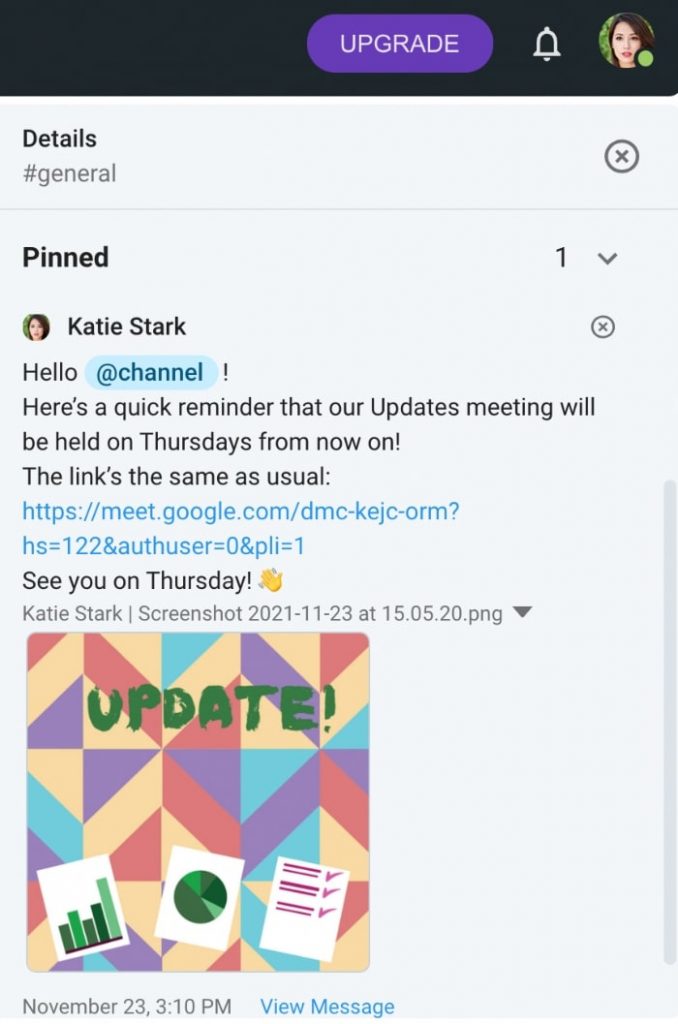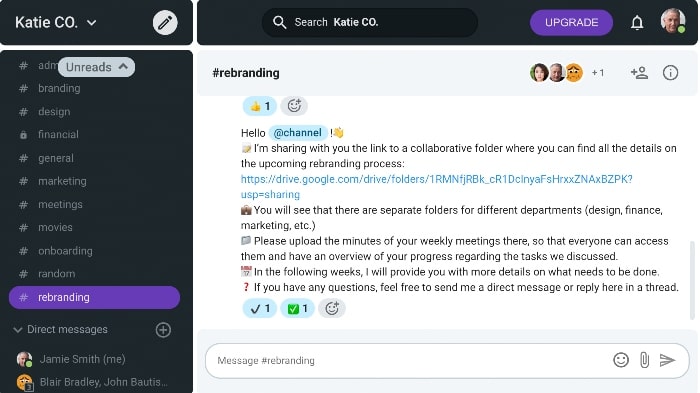“Old habits die hard” is more than just a stale phrase we use whenever we fail to stick to a new routine. Neuroscience shows that people are actually hardwired to dislike and resist change because it brings on uncertainty. So, whenever you fall back to the same pattern two days after cutting on sweets, you can blame it on science.
In a business environment, however, change is usually a result of a carefully thought out strategy and does not depend on one person’s willpower. Yet, even a perfect change strategy is destined to fail when the person who rings the changes doesn’t keep a guard on their words.
However, it’s still possible to introduce novelty without adding fuel to the fire. The secret lies in change communications.
That’s why we’ve listed all you need to know about communicating change in this blog post— from practical examples to the best strategies for letting your team know about all the transformations. From now on, whenever you break the news, you’ll get the all-clear.
Table of Contents
What is change communication?
Change communication is a communicative process of transmitting information about change. At the workplace, it usually involves letting the employees know about the upcoming changes, how they concern them, and why they’re important.
According to organizational management literature, adequate change communication needs to be sincere, clear, and timely. When the employees are kept in the dark or have to decipher the meaning behind your message, they are less likely to accept the change — simply because they lack the motivation or feel threatened by the transformation.
What is the difference between change management and communications?
Although a properly communicated message is half the transformation, change communication is just a piece of a bigger puzzle — change management.
Change management involves all the methods and strategies centered around the successful implementation of change.
In other words, it refers to all the tools necessary to give rise to an intended change — from an idea to a completed process.
These strategies vary, depending on the company’s desired outcome.
However, change management almost always includes devising an implementation plan and figuring out a communication strategy.
Change communication, therefore, as a process of issuing information about the upcoming novelties, is an inevitable element of successful change management.
What does effective change communication look like?
Let’s go over two different shapes change communications can take in practice and spot the difference a properly communicated message can make when the stakes are high.
✅ Effective change communication ✅
What was the change?
The management decided to change the main channel of their company’s internal communication.
Instead of relying on email only, they intend to introduce a team chat app.
How was the change communicated?
- The higher-ups decided to inform the team leaders first and explain the reasons behind their decision.
- The emails persistently got lost or ignored, and this resulted in frequent delays.
- They wanted their company’s communication flow to be more speedy and efficient.
- The team leaders’ task was to inform the rest of the company and let them know of the benefits the team chat app brings to them.
- They scheduled a meeting with their team members and informed them of the new decision.
- They made it clear that a new communication channel would save their time and prevent the information from getting lost.
- The leaders also mentioned that a training session for the new app will be provided so that the employees can get familiar with the software two months before its introduction.
How did the employees react to the change?
The employees were a bit surprised, but they acknowledged the disadvantages of their previous communication channel.
They were relieved to hear that they had time to get accustomed to the new app before they started using it.
❌ Ineffective change communication ❌
What was the change?
The accounting department was understaffed, so the paychecks were frequently 2-3 days late.
The management decided to hire two more accountants to ensure the system of issuing payments falls into place.
However, the new addition implies that next month’s paychecks will be delayed for two more weeks on top of the usual delay until the newly developed system starts operating.
How was the change communicated?
- The company’s CEO decided to send an email to all the team leaders informing them of the possibility of a delay.
- The leaders were aware that they needed to issue this information down the hierarchical ladder, but they weren’t sure why the payment delay was taking place.
- Since they didn’t have more details on this issue, they just let everyone from their team know about the situation by sending them a generic email.
How did the employees react to the change?
Upon receiving the email, the employees were confused.
The lack of information about the upcoming payment delay prompted speculation and worry among the employees.
They started wondering if there was a looming financial crisis they were not informed about. Some of them even began actively searching for new jobs.
Communicate change effectively over Pumble
Why is change communication important?
Change communication, although just a stepping stone to triumphant change implementation, is still crucial in managing a switch up. As we’ve previously seen, writing it off and focusing on the end goal only is equivalent to trying your luck.
With more than 70% of companies introducing adjustments failing to reach their ultimate goal, it becomes impossible to turn a deaf ear to the importance of communication during the process of change. When you keep a lid on the information regarding the expected changes, you risk your employees’ goals not being aligned with your company’s purpose. When this happens, you could be just a step away from waving your employees goodbye. Simply put, since they cannot see what’s in it for them, only the fruit it bears for you, the employees will automatically frown upon any workplace adjustments.
In line with all the hazards of poor change communication, hoping for the best should definitely not be an option.
Let’s look into detail at what happens when you let people know about the change, how they react to it, and why is an adequate change communication strategy important in leading your business to a roaring success.
Change communication transforms employees’ reactions to change
If change is the only constant, companies undergo subtle transformations on a regular basis. Sometimes, the management decides to introduce an additional overtime bonus.
Other times, a structural reorganization is on the horizon, which implies letting a number of employees go.
Regardless of whether the upcoming change is positive or negative, it always leads people to react emotionally. Psychology has even given proof that when bad news comes out of the blue, we tend to see it as even worse than it actually is.
The emotional stages that people go through when dealing with unexpected events are best explained by the Grief Cycle developed by psychiatrist Elizabeth Kübler-Ross.
Although the original model mainly focuses on the emotions that people suffering from terminal illnesses experience, it found its way into organizational management to describe people’s emotional stages when they face change. Therefore, the modified version of Kübler-Ross’s model became the Change Curve in business.
From shock, denial, acceptance, depression, experimenting to deciding and embracing the change, the Change Curve provides insight into the psychological effects an organizational change can have.

However complex the curve might appear, change communication can help successfully overcome the negative emotions the people might experience during the transformation.
Yet, providing enough clarity and information about the change speeds up the transition from shock and denial to accepting the novelty. Demonstrating empathy in change communication can further promote engagement with the new idea and help accept the change more quickly. When provided with enough details and support before the change takes place, people are less likely to see it as a threat, as the mentioned psychological research has demonstrated.
Change communication helps people accept change
When dealing with surprising events, shock and denial are the two most common human reactions that lead people to resist the new thing. However, the resistance can also be successfully avoided if the information is not stored behind closed doors. Dannemiller’s formula for change demonstrates how change communication can help prevent the crisis even when a sweeping change is around the corner.
According to Dannemiller, a successful organizational change always includes three factors:
- dissatisfaction with the current situation,
- a vision of future possibilities, and
- the first steps towards the vision.
Dannemiller’s formula for change is, in fact, a multiplication formula consisting of change (C), dissatisfaction (D), vision (V), first steps (F), and resistance (R).
This is how it looks like:
C = D × V × F > R
As the formula shows, the final product of the three factors (D × V × F) needs to be greater than the resistance (R) so that a successful change (C) can take place.
Let’s say you intend to introduce monthly reports as a standard practice across all the departments.
If you don’t communicate the vision behind this idea, or you don’t clearly state the faultiness of the existing system, you risk the resistance to change going overboard. Wondering what’s in it for them except for the additional workload, the employees could turn in their reports late or even ignore this decision altogether.
To prevent a change from coming to a halt even before its official launch, don’t be afraid to overcommunicate. Describing the reasons behind the expected change, highlighting the flaws of the current state of affairs, and clearly stating the improvements the new thing can bring about for everyone involved could reduce the struggle and even generate enthusiasm.
Best practices to communicate changes
As science has explained multiple times, it’s only natural for humans to resist change.
Being creatures of habit, adjusting to innovation, or breaking out of routine usually leads us to resist this process.
Yet, that doesn’t necessarily mean people are unable to accept change with open arms.
The following practices of spreading the word about an upcoming workplace change can help you witness just that — a shift from the brush-off to a thrilled leap at the opportunity of change.
Use simple language
Whether you are prone to using office jargon, abbreviations, or complex words with multiple meanings, this habit might get the best of your words. When change is brewing, not paying attention to how you phrase your messages is similar to skating on thin ice. Perhaps you did have the best intention and wanted to inform your employees about the new policy introduction in a timely manner.
Still, your choice of department-specific words led most of them to disregard your message because they thought it didn’t concern them.
Eventually, when the change took place, everyone was in shock!
Using simple language instead of vague phrases helps avoid confusion, and it reduces the risk of your employees receiving a signal that you might be hiding something. When you give the outright information, you remove the uncertainty from the new situation, and voilà — everyone’s one step closer to accepting the change.
💡To find out how to tread your words so that everyone from your team receives a clear message, make sure not to miss our blog post: Business communication words and phrases: what to use and what to avoid.
Make your message employee-focused
Before communicating change to employees, it’s always better to double-check your message and try to analyze it from their perspective. If it’s not clear why they should happily accept the change, or it sounds even slightly condescending, perhaps it’s better to delete it and start all over again.
Regardless of whether you intend to inform everyone of the rebranding strategy that concerns only several departments, or you plan on sending employees a message about an upcoming payment reduction, your message should be as supportive, honest, and empathetic as possible. Even when there are no benefits for the employees to reap from the upcoming organizational change, try to share that aspect openly too. Your team members will respect your honesty and be more likely to stick through the transition instead of taking flight from the uncharted territory that comes with change.
Use the right communication channels
Perhaps you’ve put effort into polishing your words and informing everyone of the approaching changes months ahead.
You are confident that you have double-checked your mailing list before clicking the Send button.
You have even scheduled a video call with all the leaders to cascade the information down.
Yet, when the time came, some people were blown away.
Not expecting the change, they felt betrayed, shocked and confused.
What went wrong?
In all likelihood, a communication break took place. Placing your faith in emails when communicating a far-reaching decision sounds like pressing your luck when there’s always a possibility of your message ending up in spam.
When a piece of information needs to be delivered to every person in a company, it’s always better to ensure it doesn’t get lost or buried under other data. Team chat apps, such as Pumble, let you pin your message so that it cannot fly under the radar.

Don’t forget about two-way communication
Although communicating change always falls under the category of downward communication, the success of the outcome is built on your ability to hear out the other side of the story, which would be impossible without a window for upward communication.
Setting the stage for asking questions and sharing their viewpoints of the novel situation removes guesswork and speculation and lets the employees know that their opinion is highly valued. Apart from that, hearing the team out doesn’t leave room for them to feel like the change is beyond their control, especially when there’s a great transformation a short distance away.
After announcing the change, let everyone know that you are available to discuss it at all times. Encourage your team scheduling one-on-one video meetings with you or sending you a direct message in the team chat app. This way you’ll be able to anticipate any potential bottlenecks and worries that might prey on your teams’ minds.

Connect with your coworkers easily on Pumble
Share the vision behind the decision
Getting everyone on the same page when they are expecting a large-scale transformation that may impact them greatly can be challenging. However, the change narrative you communicate with the employees can make all the difference between a supported idea and a transition gone bad.
Before announcing the possibility of something changing within the organization, it’s always best to double-check whether your announcement points out the main reasons for initiating the change. Painting the picture of the vision behind it and the outcomes resulting from the new situation eliminates the question mark over the idea and helps the employees go along with it. When in doubt whether the message you send will show itself in the best light, try to craft it by answering the following questions:
- How will this change impact the entire organization’s workflow?
- What will be the direct influence of the change on the employees’ workflow?
- What are the tangible outcomes of the upcoming change?
- What are the advantages of this change?
- Are there any disadvantages that might impact the employees?
Enable easy access to important documents and information
Whether the announced innovation involves introducing a new digital tool, presenting a new leave policy, or changing a workflow procedure, keeping all the data safely sheltered in one place plays a vital role in a successful change communication process.
Sometimes, the employees might need a reminder of all the steps they need to take, or they just need to double-check the new policy to ease their concerns. Instead of everyone wandering around looking for the source of information, keep the information organized and in one place. You can choose to create a channel in your team chat app to store everything there is to know about the novel situation. A dedicated virtual place where everyone can circle back to can also be a great spot to celebrate and highlight each successful milestone along the way.

Organize your communication with Pumble’s dedicated channels
Don’t keep the managers in the dark
In times of change, if you leave room for shooting in the dark instead of laying out all the information, you run a risk of your idea going to rack and ruin and losing employees’ trust. This is especially important if you plan on informing the team leaders and managers at the outset and expect them to pass the notice further. If they do not understand why the change is happening, providing support and enough details to the rest of the team would be out of the question.
Instead of keeping the information behind closed doors, get down to the facts and try to address what the change means for the leaders first. Provide them with everything they need to do to model and initiate the change.
Let’s say you intend to hire several new people to reduce the workload in different departments. When this happens, you need to let the managers know the exact date the new hires will be arriving, what is expected of them in the onboarding process, and how this change will impact their team. This way, by getting all the details out in the open, you eliminate potential stumbling blocks before the change sets in.
Wrapping up: Change communication closes the book on uncertainty
They say that variety is the spice of life, yet, tampering with people’s habits and routines almost necessarily causes a stir.
This is especially true in a business setting. Introducing a change at the workplace is often similar to walking a tightrope. Even when the new situation implies a change for the better, it still requires time until the dust settles and everyone gets used to the newly-developed conditions.
Yet, weighing your words wins the day, however uncertain the upcoming change might be. By carefully plotting your change communication strategy, you give rise to the agreement instead of fear and alarm. With all the information out in the open and your employees’ minds at ease, you get to sit back and watch the successful upshot of all the changes unfold.









